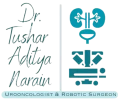Prostate cancer is one of the most common cancers affecting men worldwide. Thanks to advancements in medical technology, surgical treatments—including robotic-assisted prostatectomy—have significantly improved survival rates and quality of life post-surgery. However, recovery after prostate cancer surgery involves physical, emotional, and lifestyle adjustments.
This article provides a comprehensive guide to life after prostate cancer surgery, covering recovery timelines, potential side effects, rehabilitation strategies, and expert insights from Dr. Tushar Aditya Narain, a leading Uro-oncologist and Robotic Surgeon at Max Smart Super Speciality Hospital, Saket, New Delhi.
Understanding Prostate Cancer Surgery
Prostate cancer surgery, known as a radical prostatectomy, involves the removal of the prostate gland and surrounding tissues to eliminate cancerous cells. The two primary surgical approaches are:
- Open Prostatectomy – A traditional surgical method involving a larger incision.
- Robotic-Assisted Laparoscopic Prostatectomy (RALP) – A minimally invasive technique using robotic precision, resulting in smaller incisions, less blood loss, and faster recovery.
Dr. Tushar Aditya Narain, a globally trained Uro-oncologist with expertise from University College London Hospital, specializes in robotic urological cancer surgeries, offering patients cutting-edge treatment with reduced complications.
Immediate Post-Surgery Recovery (First Few Weeks)
- Hospital Stay & Initial Healing
- Most patients stay in the hospital for 1-3 days after robotic surgery (compared to 3-5 days for open surgery).
- Catheter use is common for 1-2 weeks to assist urination while the urethra heals.
- Pain Management
- Discomfort is typically mild to moderate, managed with prescribed painkillers.
- Robotic surgery patients report less pain due to smaller incisions.
- Dr. Tushar uses a specialized nerve blocking technique called the Transversus Abdominis Plane Block or the TAP block which blocks the pain carrying nerves for 48-72 hours resulting in minimal pain following the surgery.
- Physical Activity Restrictions
- Avoid heavy lifting (more than 5-10 kg) for 4-6 weeks.
- Walking is encouraged to prevent blood clots, but strenuous exercise should be avoided.
Short-Term Recovery (First 3-6 Months)
1. Regaining Urinary Control
- Urinary incontinence is common initially, with most men regaining control within 1-3 months.
- Pelvic floor exercises (Kegels) help strengthen pelvic floor muscles.
- In severe cases, with incontinence lasting more than a year, artificial urinary sphincters may be recommended.
2. Sexual Function & Erectile Dysfunction (ED)
- Nerve-sparing robotic surgery improves the chances of preserving erectile function.
- Recovery can take 6-24 months, with medications (PDE5 inhibitors like Viagra) or vacuum devices aiding rehabilitation.
- Dr. Narain emphasizes penile rehabilitation programs to enhance recovery.
3. Follow-Up Care & Monitoring
- Regular PSA tests ensure cancer has not returned.
- Nutritional guidance (high-protein, fiber-rich diets) supports healing.
Long-Term Recovery & Lifestyle Adjustments
1. Emotional & Psychological Well-being
- Many men experience anxiety or depression post-surgery.
- Support groups, counseling, and therapy can help.
- Dr. Tushar runs a prostate cancer support group program which has more than 500 prostate cancer patients who meet regularly to share their journey through this cancer
2. Exercise & Fitness
- Gradual reintroduction of aerobic and strength training improves overall health.
- Pelvic floor physiotherapy aids in urinary and sexual recovery.
3. Dietary Changes
- Reduce processed foods and red meat to lower cancer recurrence risk.
- Increase fruits, vegetables, and omega-3 fatty acids for prostate health.
Why Choose Dr. Tushar Aditya Narain for Prostate Cancer Surgery?
Dr. Tushar Aditya Narain is a leading Uro-oncologist and Robotic Surgeon at Max Smart Super Speciality Hospital, Saket, New Delhi, bringing international expertise from University College London Hospital. His specialized training in robotic-assisted urological cancer surgeries ensures:
✅ Minimally invasive procedures with faster recovery
✅ High precision in nerve-sparing techniques to preserve urinary & sexual function
✅ Comprehensive post-operative care with personalized rehabilitation plans
✅ Extensive research background (50+ peer-reviewed publications) ensuring evidence-based treatment
Patients choose Dr. Narain for his:
✔ World-class robotic surgery skills
✔ Compassionate, patient-centered approach
✔ Multidisciplinary cancer care involving oncologists, radiologists, and physiotherapistss
Real-World Recovery Stories
Case Study 1: 58-Year-Old Executive
- Underwent robotic prostatectomy with Dr. Narain.
- Regained full urinary control in 2 months and erectile function with rehabilitation.
- Returned to work in 3 weeks.
Case Study 2: 65-Year-Old Retired Teacher
- Initially struggled with incontinence but improved with pelvic floor therapy.
- Now leads an active lifestyle with no cancer recurrence after 5 years.
Conclusion
Recovery after prostate cancer surgery is a gradual process, but with advanced robotic techniques, expert care, and proper rehabilitation, most men regain a high quality of life. Dr. Tushar Aditya Narain stands at the forefront of urological cancer care, offering cutting-edge treatments with compassion and precision.
If you or a loved one is considering prostate cancer surgery, consulting a specialist like Dr. Narain can make a significant difference in recovery outcomes.
